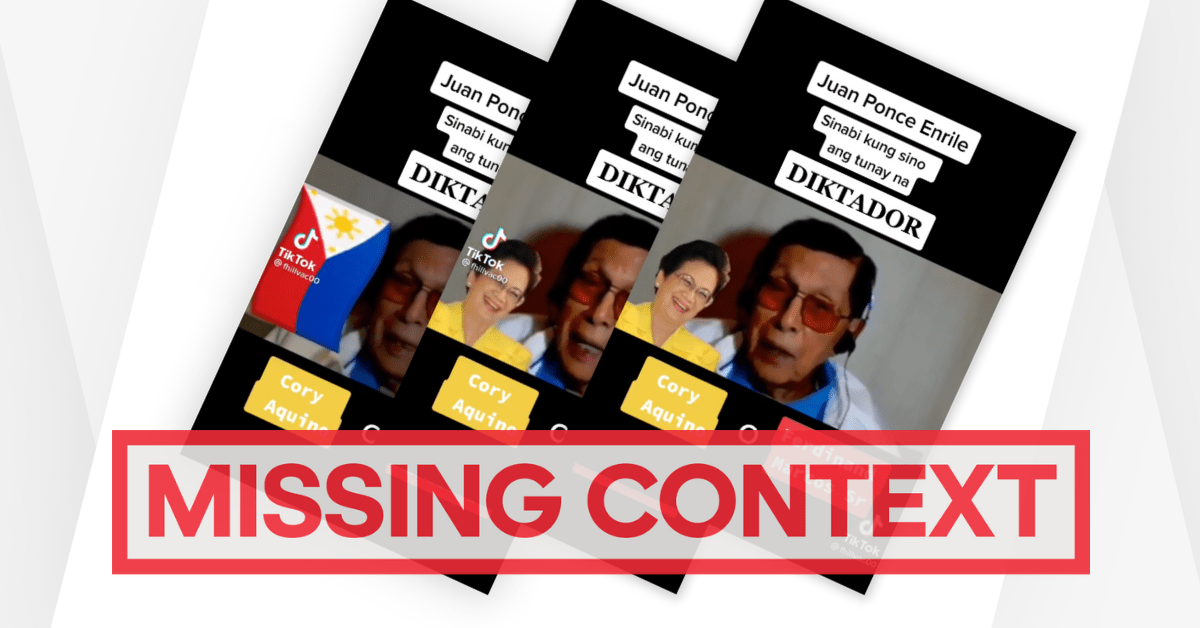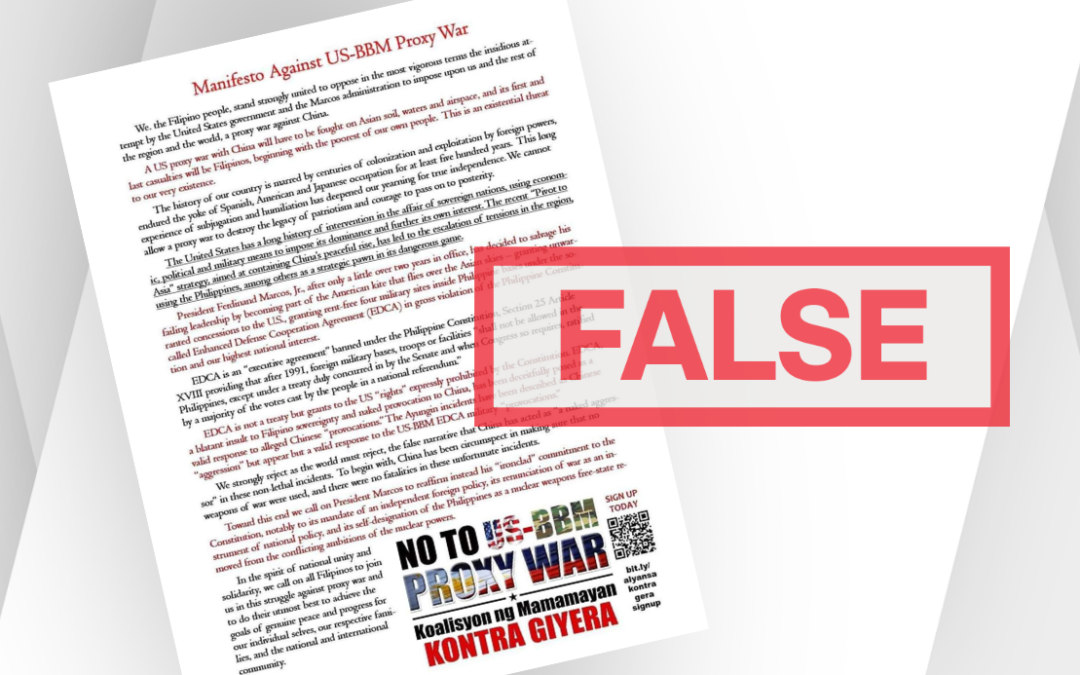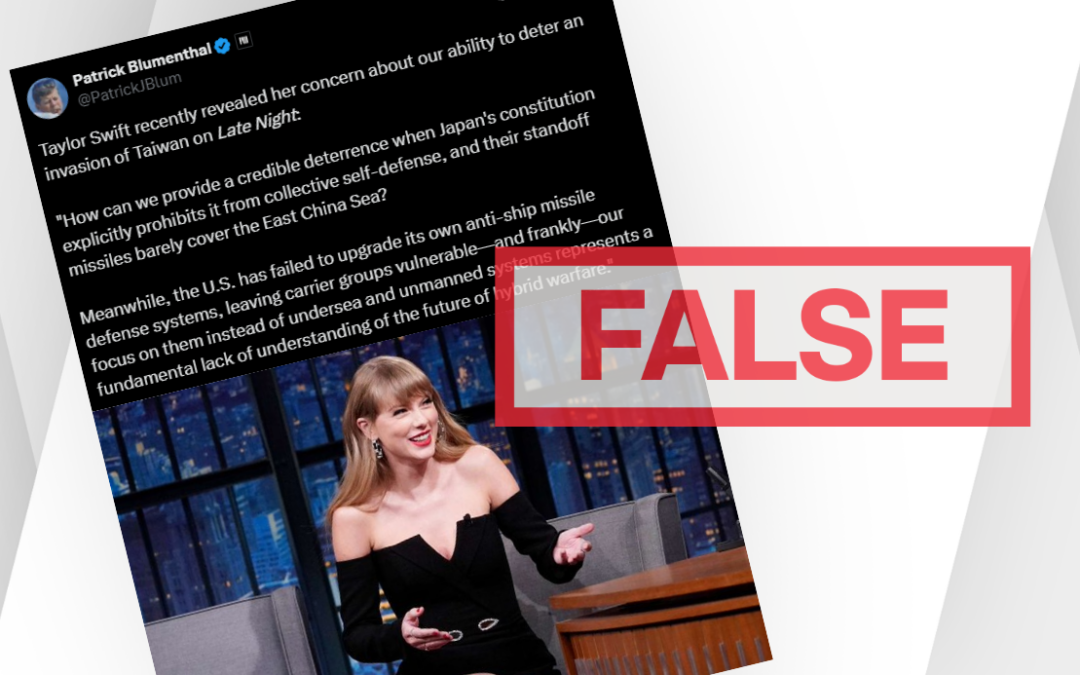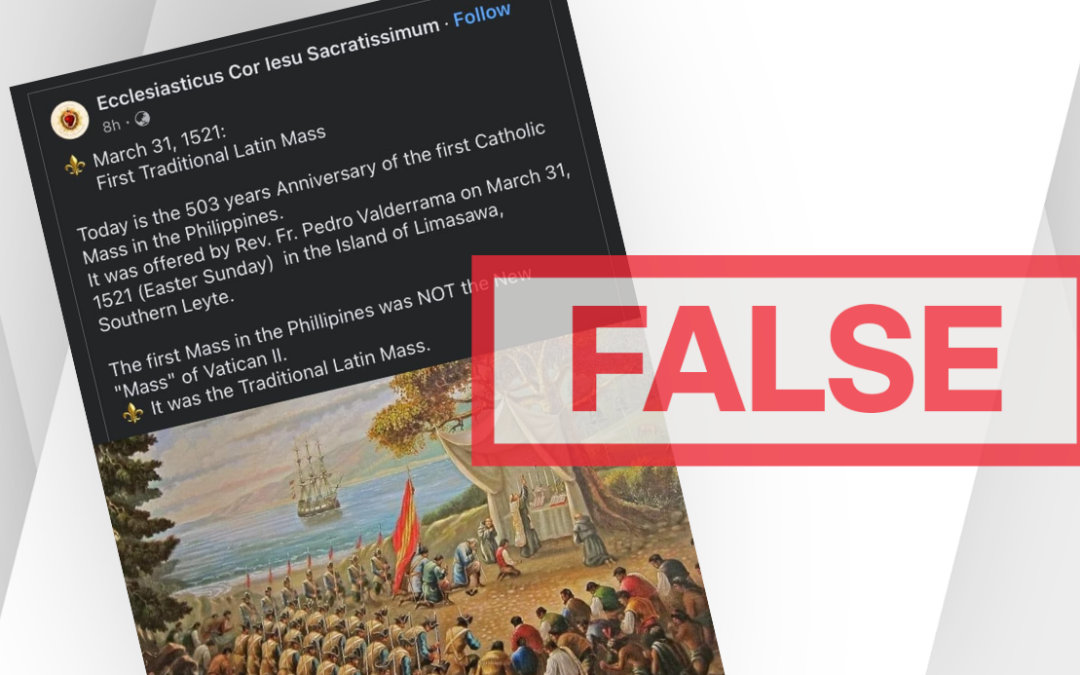
Cory Aquino’s “revolutionary” charter was intended as a transitory constitution. It stated that ‘during the period of transition to a New Constitution it must be guaranteed that the government will respect basic human rights and fundamental freedoms.’

CLAIM: Cory Aquino, not Ferdinand Marcos Sr., was the real dictator under a revolutionary constitution
RATING: MISSING CONTEXT
Key context was missing in an oft-repeated claim by ex-senator Juan Ponce Enrile that it was Cory Aquino, not Ferdinand Marcos Sr., who was the real dictator when she rolled out a revolutionary constitution following the 1986 EDSA People Power Revolution.
Aquino’s legacy as a democracy icon has been under attack since the return of the Marcoses to presidential power. In a video clip originally from TikTok and shared as a “reel” on Facebook by user Joshua Valles, Enrile, who has come out of retirement to become chief presidential legal counsel of President Ferdinand Marcos Jr., was asked who the real dictator was: Aquino or Marcos Sr.?
Enrile, one of the key players of the 1986 revolt who later had a falling out with Aquino after the power grab dubbed “Good Save the Queen,” minced no words against the late former president and widow of assassinated senator Benigno Aquino Jr.
“Gumawa siya ng revolutionary constitution, ‘yun ang tunay na diktadurya. Tanungin niyo sina Justice Carpio (retired Supreme Court justice) kung ano talaga ‘yon. ‘Yun ang talagang nagbigay ng power of dictatorship kay [Cory Aquino].”
(She wrote a revolutionary constitution, that’s the real dictatorship. Ask Justice Carpio what that really was. That gave the real power of dictatorship to [Cory Aquino]).”
Enrile’s claim in the video clip, which has been liked more than 9,000 times and commented on more than 1,200 times on Facebook, needs more context.
The former senator was referring to the “Freedom Constitution” promulgated by Aquino through a proclamation a month after the February 1986 revolt. It abrogated the 1973 Constitution that allowed the late dictator to declare military rule.
The “revolutionary” charter was intended as a transitory constitution. On the proclamation’s fourth whereas clause, it stated that “during the period of transition to a New Constitution it must be guaranteed that the government will respect basic human rights and fundamental freedoms.”
While the charter gave Aquino legislative authority and the power to reorganize the government, it required her to appoint “within sixty (60) days from date of this Proclamation” a commission to draft a new constitution.
The commission finished the new constitution in October 1986, and the charter was ratified by a plebiscite in February 1987.
How about Marcos Sr.? Enrile can best attest to what happened, having been Marcos Sr.’s defense chief and martial law administrator.
On Page 468 of his “Juan Ponce Enrile: A Memoir,” Enrile states that Marcos Sr. eventually saw the need to soften the “authoritarian image of martial law.” Martial Law, proclaimed by Marcos Sr. in 1972 on the pretext of a threat of a communist takeover, had the effect of prolonging the president’s stay in power.
Marcos Sr., he recalled, had to call a “Batasang Bayan” that gave the public impression of being a legislative body, when in reality, Marcos Sr. continued to hold legislative power with the assistance of his Cabinet “as a consequence of martial law.”
The difference between Aquino and Marcos Sr.?
Aquino was a “dictator” for about a year. Marcos Sr.’s Martial Law officially prevailed from 1972 to 1981, during which, according to Amnesty International, military rule “unleashed a wave of crimes under international law and grave human rights violations, including tens of thousands of people arbitrarily arrested and detained, and thousands of others tortured, forcibly disappeared, and killed.”
Five years later, Marcos Sr. suffered the fate of dictators and was ousted by People Power, a historical event that his heirs and supporters are now trying hard to darken, if not erase.
This fact-check was produced by PressOne.PH as part of a fact-checking grant from the Philippine Fact-Checker Incubator (PFCI) Project. The PFCI supports news organizations to allow them to meet global fact-checking standards under the International Fact-Checking Network’s Code of Principles.
PressOne.PH believes that fact-checking is essential to combating misinformation and disinformation, and in informing and educating citizens and voters. Read more of PressOne.PH’s Fact-Checking Policy by clicking here.
The public is welcome to send feedback or requests for fact-checks at news@pressone.ph.


FACT-CHECK: EDCA is not unconstitutional
: A manifesto shared by a pro-China personality falsely claimed that the Enhanced Defense Cooperation Agreement between the Philippines and the United States is banned under the constitution.

FACT-CHECK: Taylor Swift did not make any comment about US ability to stop war in Taiwan
An X user made the false claim that Taylor Swift had commented about the United States’ naval capability to deter an invasion of Taiwan.

FACT-CHECK: Facebook post uses wrong painting to depict first Mass in PH
A Facebook post used the wrong painting to depict what it described as the first Mass in the Philippines.